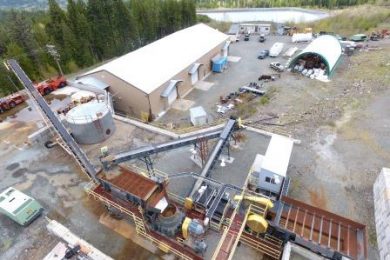Wolf Wiese CEO of Golden Dawn Minerals reported, September 27, on activities at the Greenwood precious metals project. “Yesterday the company has given the required 72 hours’ notice to the BC Ministry of Environment that mobilization of equipment and crews are nearing readiness to commence dewatering the Lexington mine. The company currently has a mine contractor on site and is working with its environmental consultant to carry out this project according to required conditions. The primary dewatering program is estimated to take approximately four weeks, with discharge at up to 1,000 m3/d, and will be followed by continual dewatering at up to 35 m3/d. The mine is accessed from two declines, which will be rehabilitated as the mine is de-watered.”
Once the mine is pumped out, permanent mine services, including mine electrical and ventilation can be installed to facilitate underground mine operations. Initial work will consist of mapping and sampling of the workings and definition drilling to validate the resources and support a test mine program design. Test mining would provide mill feed for the Greenwood process plant.
Exploration drilling continued in late August at the Golden Crown property, which hosts the company’s processing plant and tailings facility. Drilling is currently underway to verify, infill and extend the known mineral resources on the property. Fifteen holes have been completed to date. This work is being undertaken in anticipation of permitting the Golden Crown mine in the second half of 2018. Also during this season, the company’s geological personnel have been prospecting numerous historic mine sites and mineral showings, in order to delineate further drill targets with a view to increase mill feed tonnage over the ensuing years. All historic mines and active mines are within a 15-km radius of the Company’s mill.
A limited surface diamond drilling program was completed at the May Mac mine after the successful and extensive underground drill program completed in late spring of this year. A total of 1,886 m were drilled in eight holes from surface. The holes tested the northwest strike continuation of the Skomac vein system, with mineralized quartz veins intersected in seven of eight holes, and disseminated copper mineralization intersected in the overlying rock unit. Significant assay results were obtained in hole BF17-03, which intersected 1.13 g/t Au, 23.0 g/t Ag and 0.7% Pb over 0.36 m between 204.34 and 204.7 m depth. Previously unknown copper mineralization was intersected in hole BF17-08 between 45.0 and 45.79 m (0.79 m), which contained 0.24% Cu.
The drilling results indicate the vein system extends significantly beyond the mine workings to at least 215 m to the northwest from the termination of the level 7 drift. Further drilling is warranted to test the structure for mineralized shoots. Due to the topography of the area, the vein system is covered by an increasing thickness of cover rocks along the northwest strike extension. This results in increased costs and difficulty in targeting the veins at depth. As such, the company will conduct follow-up drilling from underground. A permit application for extension of the 7 level of the mine and underground diamond drilling has been submitted to request approval for this program to proceed. The company has concluded that focus on extracting mill feed from the Lexington mine and processing in our facility are of highest priority.
The company has received cost estimates to restart the company’s mill, and the consensus from contractors is that the facility is in excellent shape, and refurbishment will cost approximately $270,000 and take three to five weeks to be operable. It is anticipated that work will commence to restart the mill post-dewatering of the Lexington mine to coincide with anticipated mill feed from the Lexington mine.
Lexington is just north of the border with Washington State.










